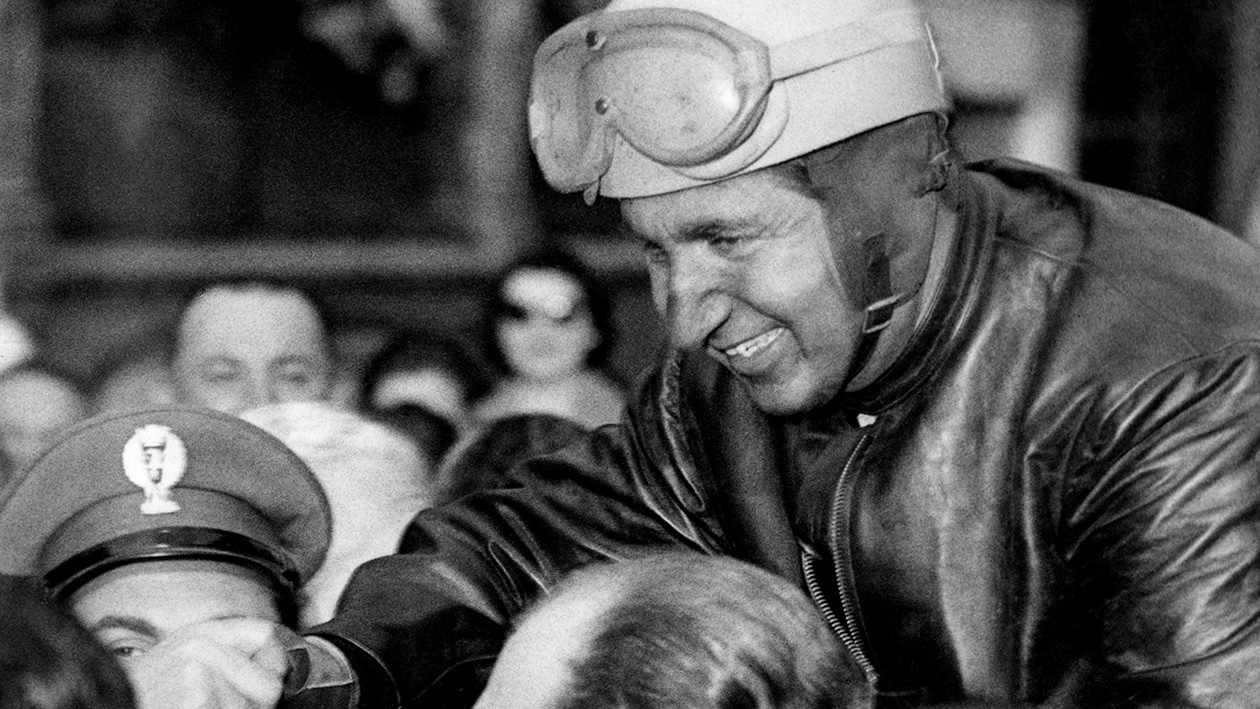Supporting the factory Ferraris were an impressive team entered by the Scuderia Guastalia under the organisation of Franco Cornacchia, the Milan Ferrari agent. Musitelli and Pezzoli had open two-seaters and Signorina Piazza and Gerini had Farina coupés, all on the new 3-litre V12 chassis. A lone Maserati from the factory was in this class, being a hurriedly prepared two-seater version of the new 2 1/2-litre Formula I car, with de Dion rear axle and everything. This was driven by Mantovani. Another lone entry was a 3-litre Gordini driven by Bordoni under the watchful eye of the "sorcerer" himself, but being painted red and run as an Italian entry.
Against all these cars were pitted a collection of English cars led by the two workmanlike 3-litre Aston Martins driven by Parnell and Collins. They had been practising and testing for some weeks beforehand and made worthy representatives of the Union Jack. They were not modified in any serious way from last year's car, being the DB3S models, now with outboard rear brakes, and having nicely moulded Perspex windshields and the passenger's side of the cockpit enclosed as much as space would permit. There was a privately entered DB3 Aston Martin belonging to Meyer, the coupé body having been lowered and smoothed out since last year, and at lone H.W.M. driven by Abecassis, this car being fitted with a Jaguar XK engine and gearbox, the chassis being comprised of Formula II parts, having transverse leaf-spring and wishbone i.f.s. and de Dion rear axle on torsion-bars. Also in this formidable class were the Austin-Healey team; they had entered for the Gran Turismo class with three cars built around the production two-seater-body but fitted with bolted-on "hard-tops" of the type produced in quantity for normal Jaguars. M.G. and suchlike. None of the cars were accepted by the scrutineers as regulations for the Gran Turismo class were very strict and every detail had to conform with a catalogue sent in with the entry. It was this paperwork detail that Healeys had overlooked and no one was prepared to believe that the cars were standard production models. As a result they were transferred to the "big boys'" class and those of Macklin and Chiron were run as single-seaters with cockpit fairings and small Perspex windscreens, while Wisdom took a passenger. All three cars were fitted with Dunlop disc brakes and new Dunlop magnesium disc wheels that were located by five dowel pins, the wheel being held in place by a three-eared knock-off hub nut. The 2.6-litre Austin engines were the normal power plants, fitted with twin S.U. carburetters fed by an air-duct from the front of the car, and a double-pipe exhaust system ejected from the side of the cars just in front of the off-side rear wheel. Four-speed gearboxes, manufactured for Austins by David Brown, were fitted, with central remote control. The whole of the boot was occupied by a 32-gallon fuel tank, with a large filler protruding through the lid. Considering that the cars had been prepared from standard production models they looked most effective but were severely handicapped by being a half litre down on the average of competitors in the class.
From the foregoing imposing list of cars and drivers the winner of the XXIst Mille Miglia was expected and Maglioli and Taruffi were hot favourites. Hard on the heels of the big class was the 1,500 to 2,000-c.c. class and here the battle for honours was between Maserati and Ferrari. Maseratis were running one official car, but as the 2-litre sports car is now being produced in numbers the others were prepared by the factory for the new owners, some of them being delivered just before the race. Musso was the number one driver and other Maseratis were driven by Mancini (with the special Vignale-bodied car), Venezian, Scarlatti, Bertoni Bosisio and Cacciari; the last five being in standard production two-seater A6G models. Strong opposition to the six-cylinder cars was coming from Ferrari with four Mondial models, the new four-cylinder 2-litre on a chassis developed from the Formula II cars, with de Dion axle and four-speed gearboxes. Sterzi, Neri and Vittorio Marzotto had factory cars, the last named having the prototype with normal rear axle. A fourth Mondial was that of Cortese, entered by the Senderia Guastalia and both his and Marzotto's car were running without passengers and with cockpit fairings and small aero-screens, the latter also having a head-fairing. Sanesi had a 1,900C AlfaRomeo, nicely described as a Supersprint model, meaning that it looked standard but wasn't quite. A Swedish driver, Nottorp, was running a brand new Frazer-Nash Le Mans coupé, painted Italian red, and Piotti had a 2-litre Osca, being similar to the normal sports Osca but fitted with a six-cylinder Formula II type of engine. Looking rather lost amongst all this fierce machinery were three TR2 Triumphs driven by Gatsonides, Stoddart, and the third shared by Brooke and Fairman.

